17 Best Social Media Integration Tools to Power up Your Workflow
Explore top social media integration tools designed to connect your platforms, improve user engagement, and elevate your marketing strategy.

I’ve yet to meet a social media professional who didn’t wish for one more pair of hands. But since that's unlikely, we have to opt for the next best thing: social media integration tools.
Running social today means juggling a dozen platforms, from planning to handling conversations and reporting. Integrations help you automate these workflows and build a solid, comfortable pipeline for any team.
In this guide, I’ll break down the social media integration tools that can do your heavy lifting. From analytics solutions to CRMs and automation that tie your social work to real business results — discover the best tools on the market!
Key takeaways
- Social media integrations glue your workflow parts together. They link your social platforms with CRMs, automation systems, analytics dashboards, and publishing tools so data and content flow smoothly between them.
- The right integrations save time and reveal impact. Instead of switching between apps or exporting endless reports, you can track leads, conversions, and engagement in one place and tie your social results to real business goals.
- Not all integrations serve the same purpose. Some help publish and plan content, others track performance, nurture leads, or benchmark competitors. Choose based on your biggest workflow gaps.
- Keep your stack intentional. Fewer, better-connected tools often work harder than dozens of mismatched ones.
- Test before you commit. Most platforms offer free trials or demos to make sure the tool fits your needs before you bring it into your daily workflow.
What do social media integrations refer to?
Social media integrations are connections that link your social platforms with other tools in your marketing stack. They pull data, sync content, and automate workflows between systems.
These integrations work through different technical approaches, so you can choose the one that fits your goals and workflow the best:
API-based integrations from social platforms
API-based integrations connect directly to a social media platform’s official programming interface. These integrations are the foundation of most advanced social media tools. They’re built for reliability and scale, and are perfect for managing multiple accounts.
How it works: The tool talks to the platform through an approved data connection, ensuring accurate and up-to-date insights.
Example: Socialinsider uses Instagram’s API to pull analytics data directly from Instagram to your dashboard inside the tool.
Third-party connectors
Third-party connectors act as bridges between platforms that don’t natively communicate. They’re great for automating repetitive tasks or syncing data between tools.
How it works: The connector pulls data from one app and pushes it into another, creating a smooth automated workflow.
Example: Zapier linking Twitter data to your CRM.
Why turn to social media integration tools?
Even the most well-structured social teams can struggle when their stack isn’t fully connected. Data and functions scattered across platforms slow operations and blur the bigger picture.
Social media integration tools bridge those gaps by connecting scheduling, CRM, analytics, and reporting into one reliable workflow.
Here’s what that looks like in practice:
- Unified performance dashboards. See all your social metrics in one place without switching tabs or juggling exports. This gives you a quick snapshot of our overall performance — perfect for a health check in between regular reports.
- Cross-platform comparison. Benchmark channels side by side to see which drives results and where growth is slowing, helping you make faster, data-driven marketing decisions.
- Faster reporting cycles. Social media integration tools pull multi-platform reports in minutes instead of hours. When data flows automatically, your team can focus on insights, not data cleanup.
- Custom metric tracking. Monitor KPIs your native dashboards miss. For example, Socialinsider’s Organic Value estimates how much your organic results would cost in paid ads — a metric every executive would understand.
- Trend identification across networks. Social media integration tools help you spot the patterns in your content performance and use those insights to guide your creative direction.
- Better resource allocation. Integration tools give you the visibility to allocate resources based on actual performance. When LinkedIn drives 60% of your leads despite getting 20% of your content, you have the data to back a strategic shift.
Social media integration tools for streamlined social media management
Social media integration tools come with their own specializations. You can pick tools that fit your specific workflow and patch up the weak spots in your pipeline most effectively.
Let me break down the core categories (with tool options!):
Social media analytics and reporting integration tools
I once had a project where I had to gather analytics manually from Meta, TikTok, and X, and I only have two words — never again.
Tracking and analyzing cross-platform brand metrics is essential if you want to perform consistently well everywhere. Analytics integrations let you look across channels, give you more detailed metrics, and make it easier to build executive reports. Some take it a step further by adding context like competitor insights, benchmarks, and deeper audience trends.
And I know I may be biased, but I honestly think that for this category, Socialinsider is the best tool on the market right now. And here's why.
Third-party analytics platforms with cross-network insights
Unlike native analytics tools, third-party analytics platforms let you pull in data from multiple networks into one dashboard.

That means if you’re running social on both, say, TikTok and LinkedIn, you can compare performance, spot patterns, and apply learnings from one network to another.
For example, if you see a post performing nicely on LinkedIn, try to repackage it in a TikTok-friendly format and test it there. Socialinsider can show you the top-performing posts on LinkedIn, so you can easily identify the winners and reuse them on other channels:
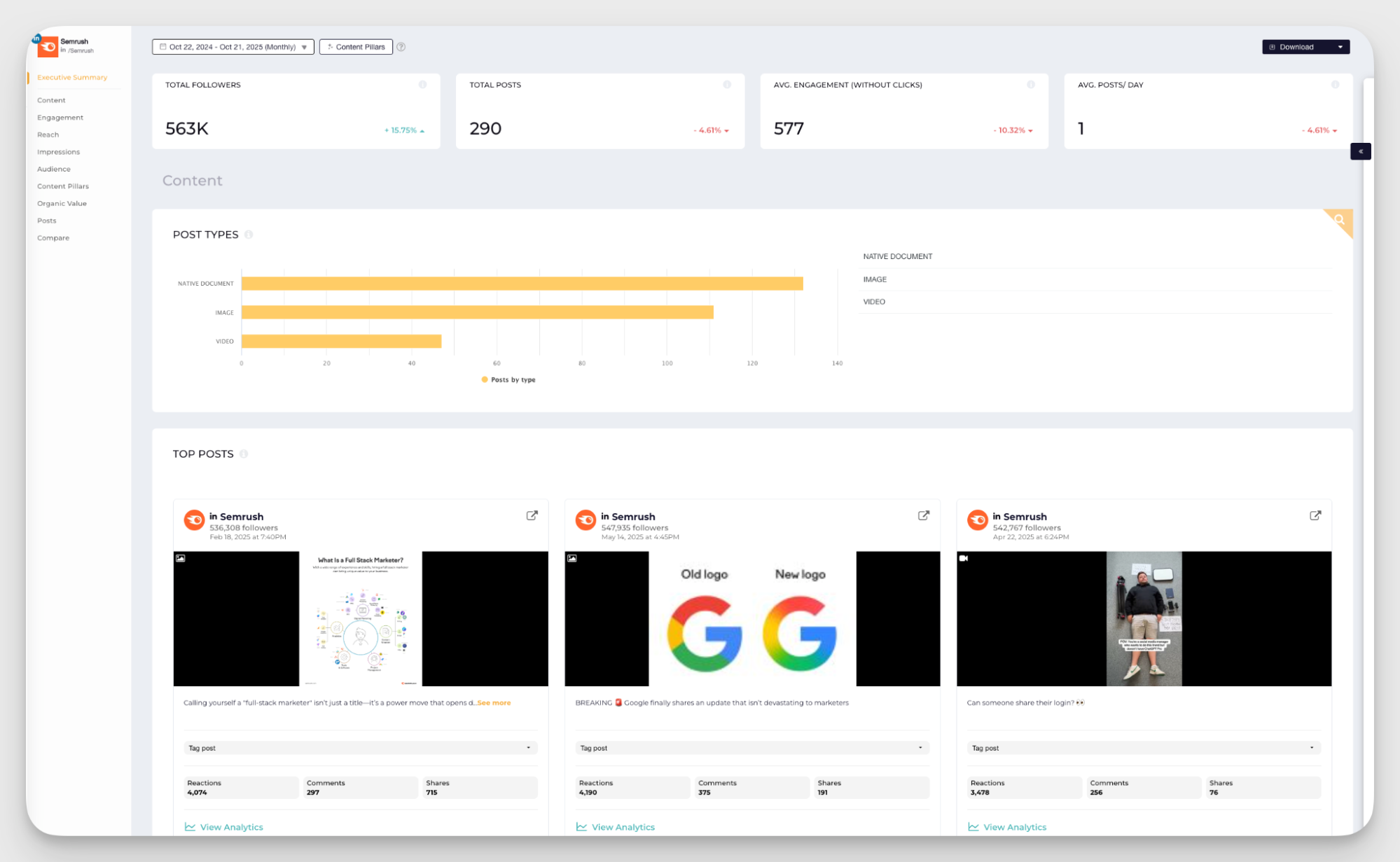
If your brand is active on LinkedIn, Socialinsider also gives you an in-depth look at what’s really important:
- Follower growth, engagement, impressions, clicks, and video views.
- Top-performing posts by type (text, image, video, document)
- Audience insights such as follower job titles, industries, and company size.
- Cross-channel comparison: how your LinkedIn page stacks against other networks or competitors.
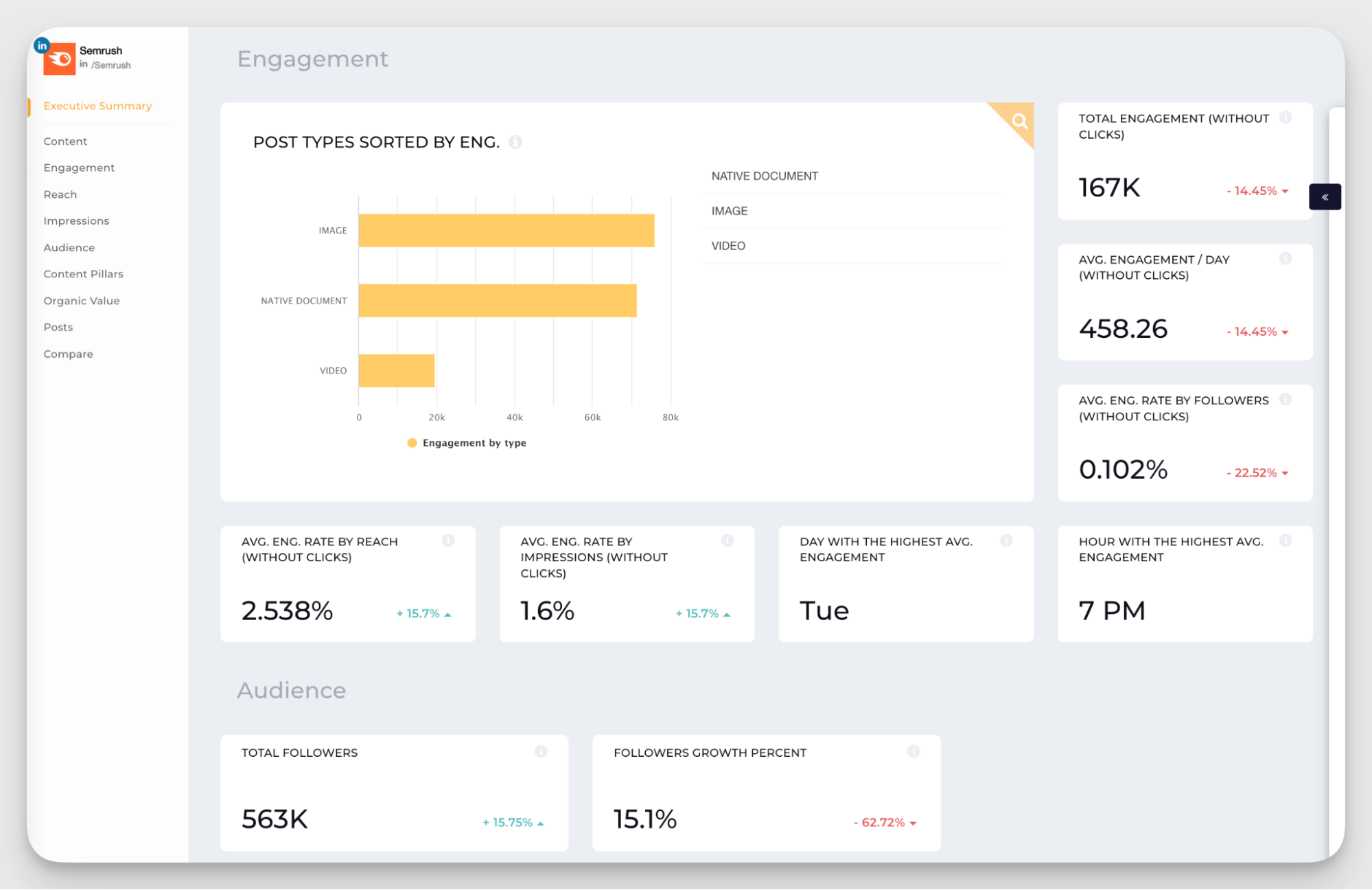
All these LinkedIn metrics sit nicely in an executive report, giving you a quick and actionable snapshot of what is happening in your brand accounts.
Socialinsider is great for us as it deals with LinkedIn, which is fantastic. We can do a quick kind of import of the channels that we're looking at and then get a nice deck out that we can just immediately work with.” — Chris, Axel Springer
understand what’s driving engagement there, too. As a part of your TikTok audit, you can track:
- Views, likes, comments, shares, saves, and overall engagement rate
- Video completion and average watch time to see what keeps people watching
- Follower growth and audience engagement trends
- Your best-performing videos, so you can double down on what works
These insights let you see how your short-form video strategy performs next to your LinkedIn content — and where the two might inform each other.
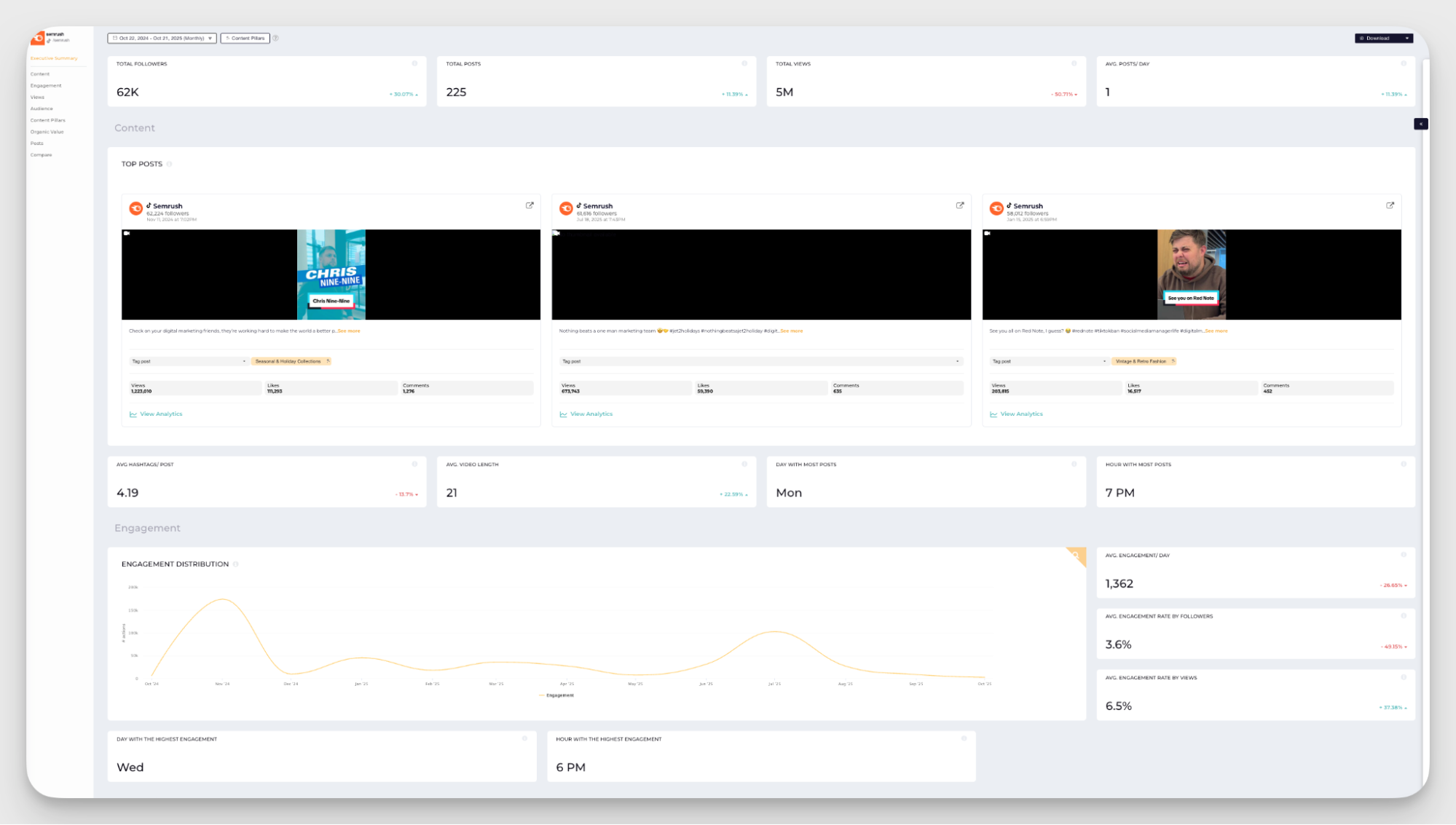
Plus, native TikTok analytics can feel shallow on desktop, so Socialinsider gives you more depth and context in one place.
We chose the tool primarily to be able to analyze TikTok in depth. Which, to be fair, Socialinsider is quite good at.” — David, WPP Media
Socialinsider supports all major social platforms to make your social media analysis easier, faster, and more impactful.
Competitive benchmarking integrations
Whenever I feel stuck on a strategy, I always turn to competitive analysis. Seeing what works for others helps you understand what could work for you and how you can bring your performance to a new level.
That’s where competitor analytics and reporting integrations like Socialinsider step in. They automate what would otherwise be a tedious task: collecting data, comparing performance, and trying to piece it all together yourself. That’s especially true if we’re talking about continuous competitor monitoring.
With Socialinsider, competitive benchmarking works on two levels:
- You can analyze competitors' channel by channel:
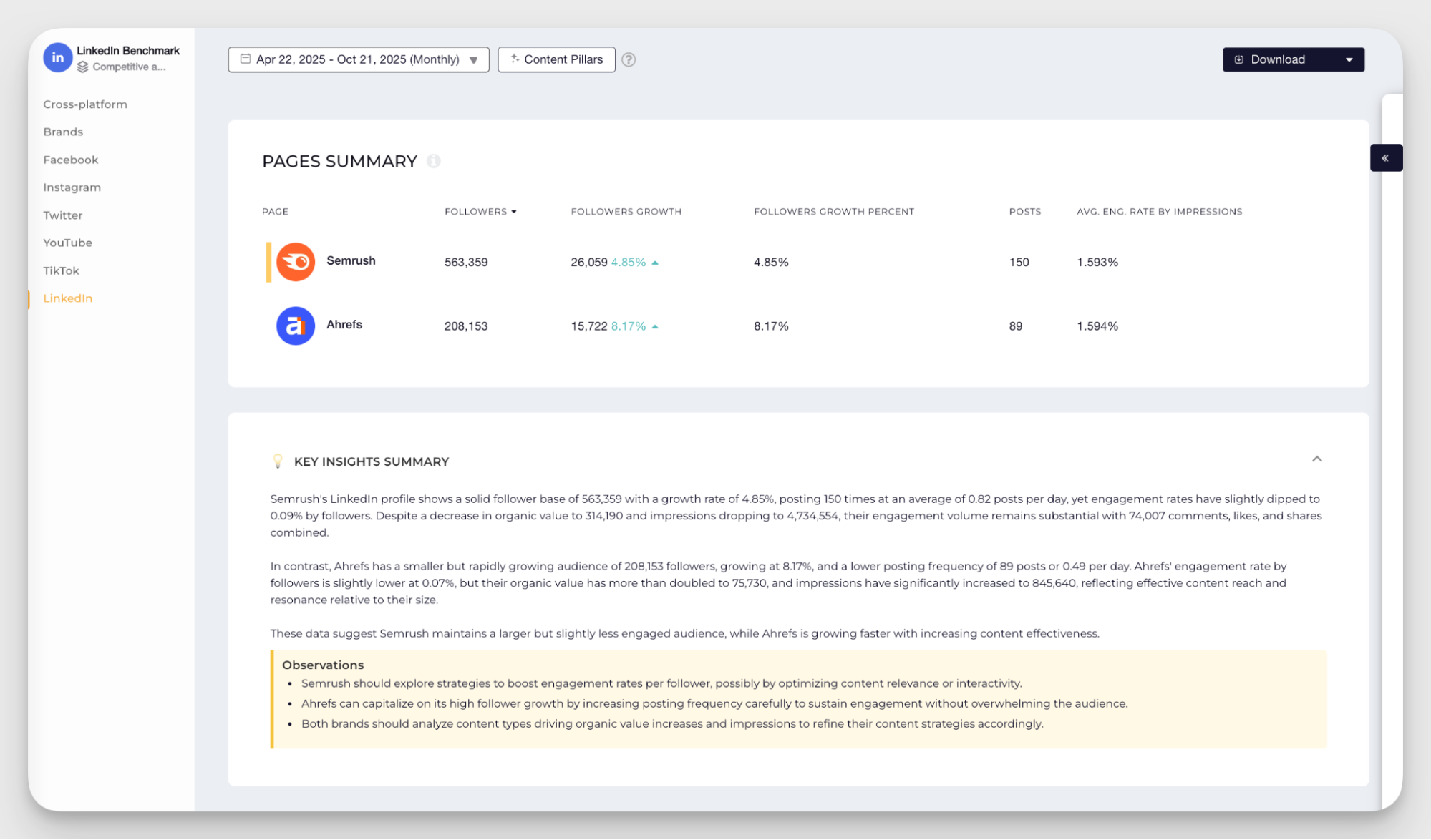
- Or you can look across multiple platforms at once, comparing where you stand on social media overall, amidst other players
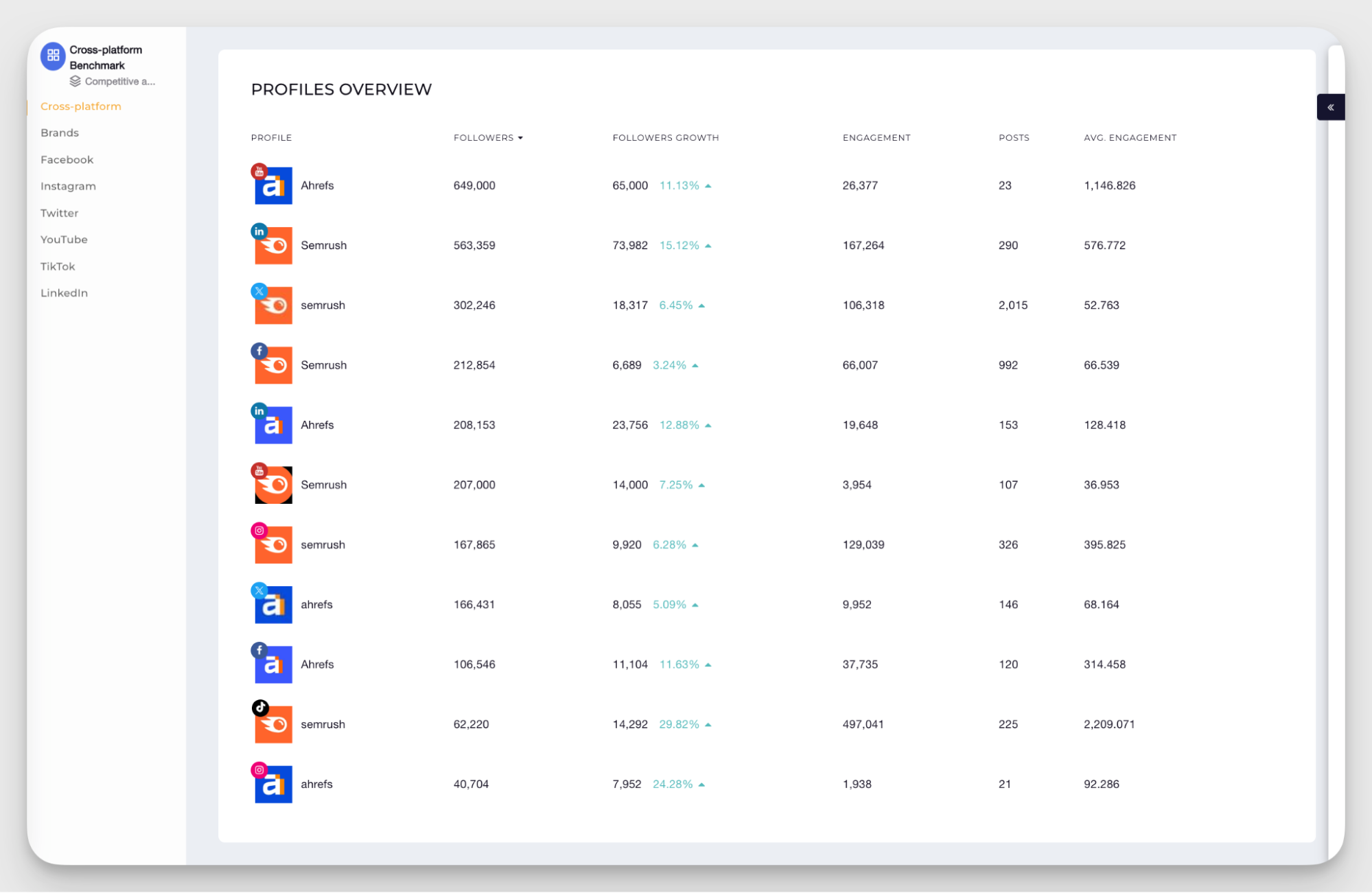
You get a clear picture of how your competitors run their social media: what types of posts perform best, how often they publish, what formats they use, and how their engagement stacks up over time.
It’s not just about spying on others, though. You can benchmark your performance against theirs within your industry to set realistic KPIs.
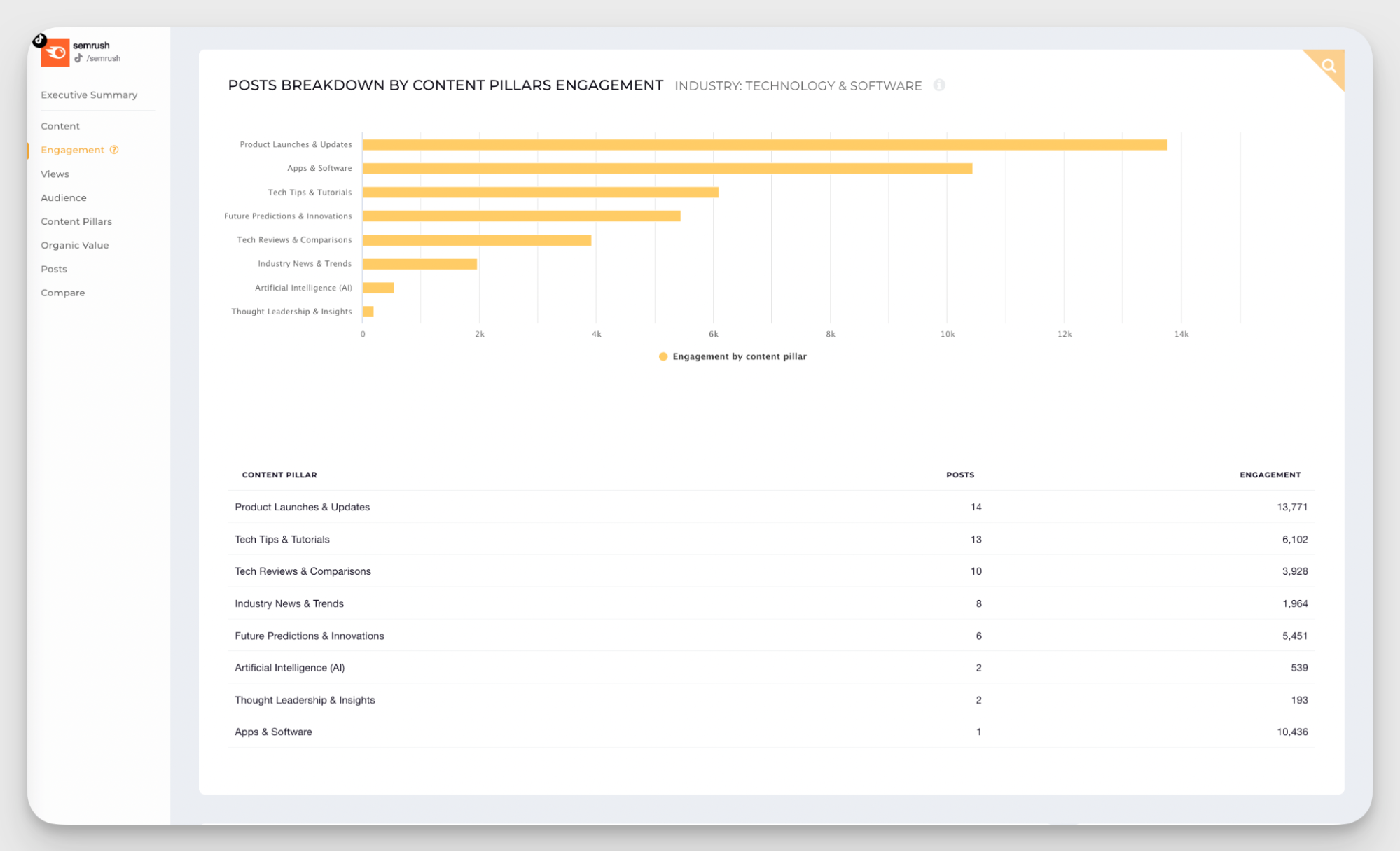
Here's one thing that I really like. Socialinsider offers AI performance insights and industry content pillars analysis, helping you understand what “good performance” actually means in your niche and where your brand has room to grow.
One of the things I liked about Socialinsider was the combined reporting and comparing with the benchmark that you have in the reports with your competitors. — Alfonso, Noxsport.
Socialinsider also includes historical data, so your competitive reports aren’t based on short-term snapshots. You can see how brands evolve their strategies over months and how you measure up in that context.
And then there’s my personal favorite feature: Organic Value. It’s an indispensable tool for proving the value of social media to executives.
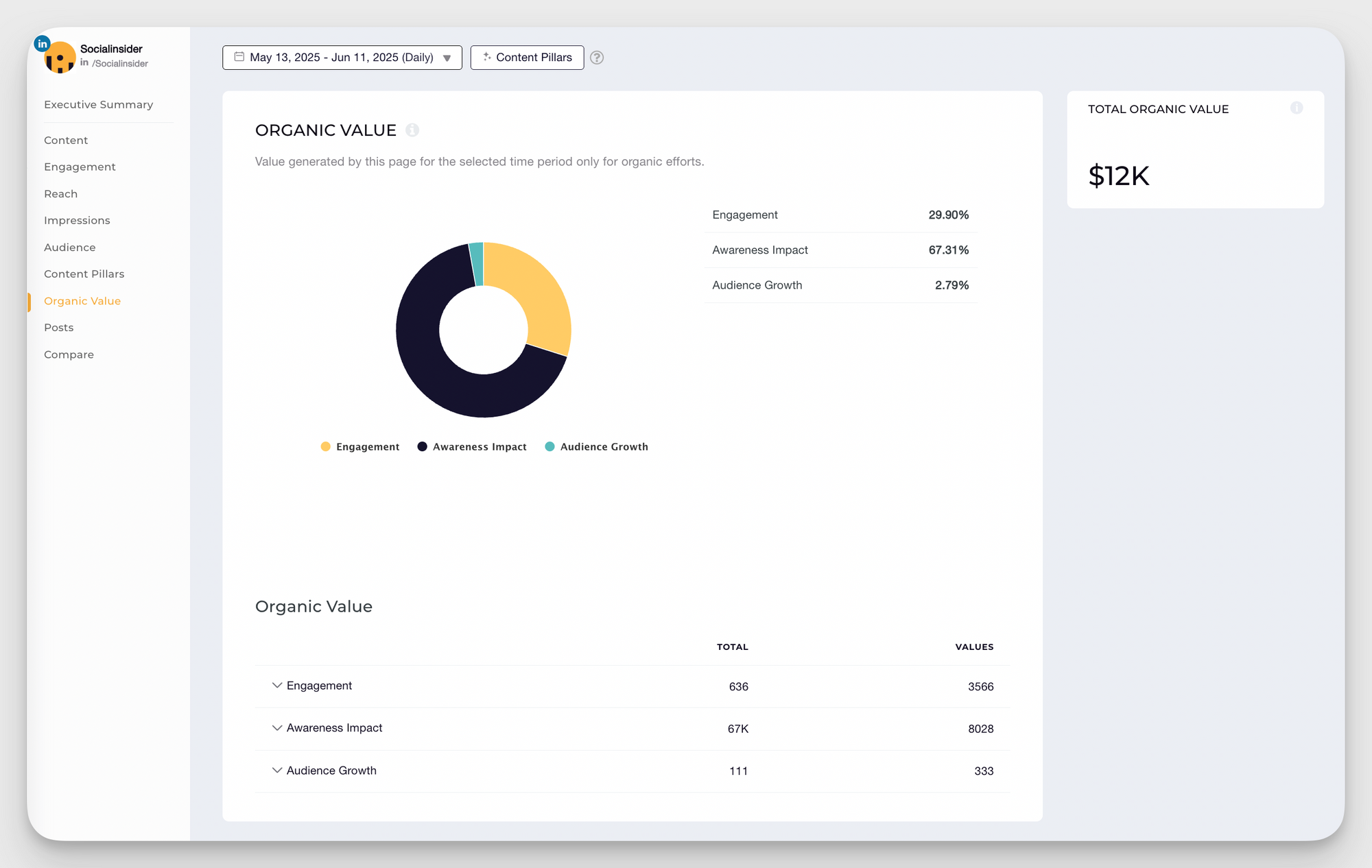
Organic Value estimates how much money it would cost to get your (or your competitors’) results through paid ads. In other words, it puts a price tag on your organic efforts — the kind of number that C-levels instantly understand.
You can calculate it using Socialinsider’s industry benchmarks or input your own values for even more precise results.
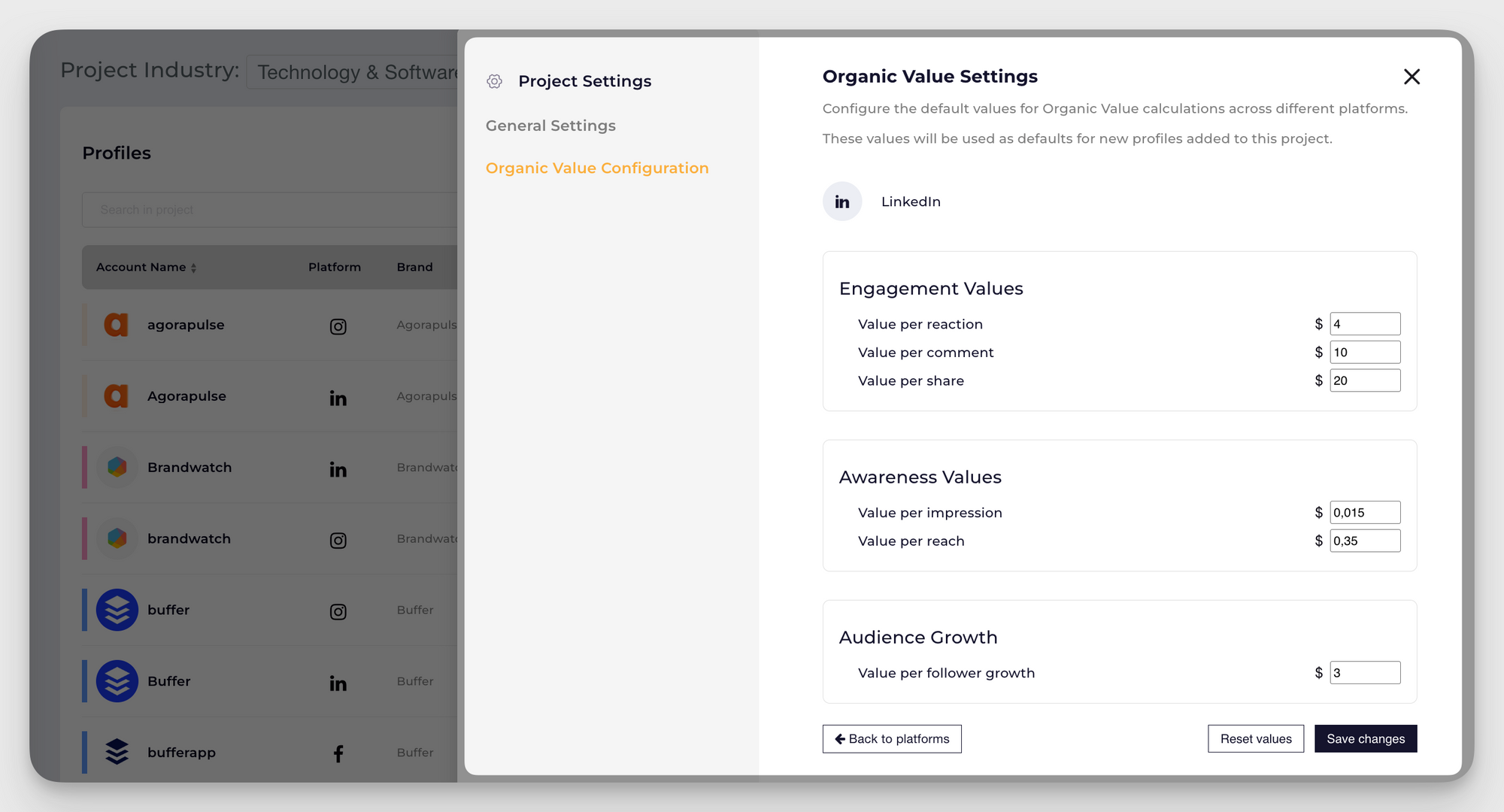
Audience engagement & community management integration tools
Audience is the star of our marketing show, and keeping an eye on their engagement, conversions, and thoughts about the brand directly affects the results we’re getting.
But tracking this data across multiple social media platforms eats up a ton of time. And when you’re scaling up, some things like support requests or direct message inquiries are getting impossible to handle manually.
This category of integration tools automates community management and ties all the loose ends in one dashboard.
Unified inbox solutions
Usually, brands have multiple social media accounts where people might try and reach out to you.
Comments and DMs pop up across TikTok, Instagram, LinkedIn, and whatnot, and keeping tabs can affect your visibility and conversions. Miss a question on Instagram while you're replying to LinkedIn comments, and you've lost a potential customer.
So here are three tools that help you keep all of your inbox tidy and organized in one app.
Agorapulse
Agorapulse brings all your comments, DMs, mentions, and reviews into one unified inbox.
I personally think that its best feature is the labeling and assignment system that helps you manage your inbox like support tickets. Tag conversations by topic, assign them to team members, and mark them as resolved when answered.
There’s also an AI assistant and automation rules that can help you do this automatically.

My opinion is that this works for teams that treat community management as seriously as customer service. If multiple people handle social responses or you need to track which inquiries got answered, Agorapulse keeps everyone coordinated.
Pricing: Paid plans start at $79/user/month (annually) for the Standard plan. Agorapulse has no free plan but offers a 30-day trial.
Statusbrew
Statusbrew is a unified inbox with built-in approval workflows and team collaboration features.
Its unified inbox has filtering and automation rules that can help you sort your inquiries. The filters automatically label incoming messages based on keywords, sentiment, or platform, then route them to the right team member — or hide them if they break your community guidelines.
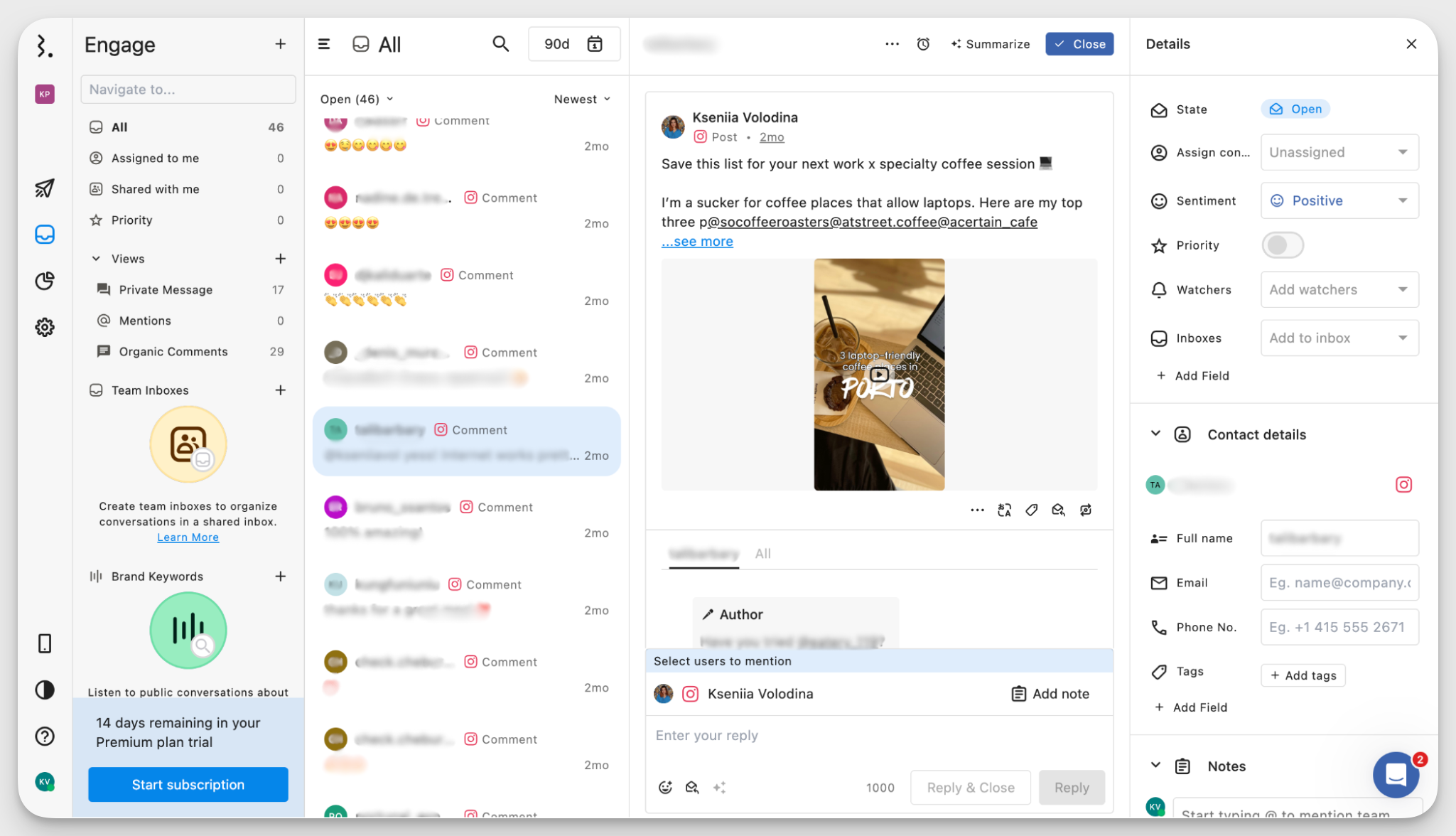
My takeaway? This is ideal for agencies or brands managing multiple accounts where different people handle different types of inquiries. If your support team answers product questions while your social team handles general engagement, Statusbrew sorts and routes everything automatically.
It also tracks response times and team performance, so you know if your reply speed is slipping.
Pricing: Statusbrew paid plans start at $69.00/month, billed annually.
Social listening capabilities
Social listening is legal eavesdropping, and no one can convince me otherwise. It’s tuning into the real conversation between your customers to see what they’re saying about you and your brand when you’re not there.
These tools are extremely helpful for competitor analysis, crisis management, sentiment tracking, and understanding what your audience really thinks about your product or campaign.
I also turn to social listening when something big is happening in the industry and I want to decide whether we want to react to it, and if we do, then how. And the three tools below usually help me do so.
Brandwatch
Brandwatch is an enterprise-level social listening and insights platform. It’s designed to help brands monitor billions of online conversations on social media, forums, and news outlets.

Brandwatch is a good fit for large brands and agencies that need deep audience analysis, cross‐channel monitoring, and competitive benchmarking across markets.
Pricing: Brandwatch doesn’t reveal its prices. However, they offer a demo call you can schedule to get a first look at the tool.
Brand24
Brand24 is a more affordable social listening tool that tracks mentions across social media, blogs, forums, and news sites.
Brand24 is great at sentiment analysis and influence score. It tells whether the conversation is positive, negative, or neutral, and how much reach all of those voices have. You can generate reports showing mention volume spikes, which helps you spot specific posts that are gaining traction.
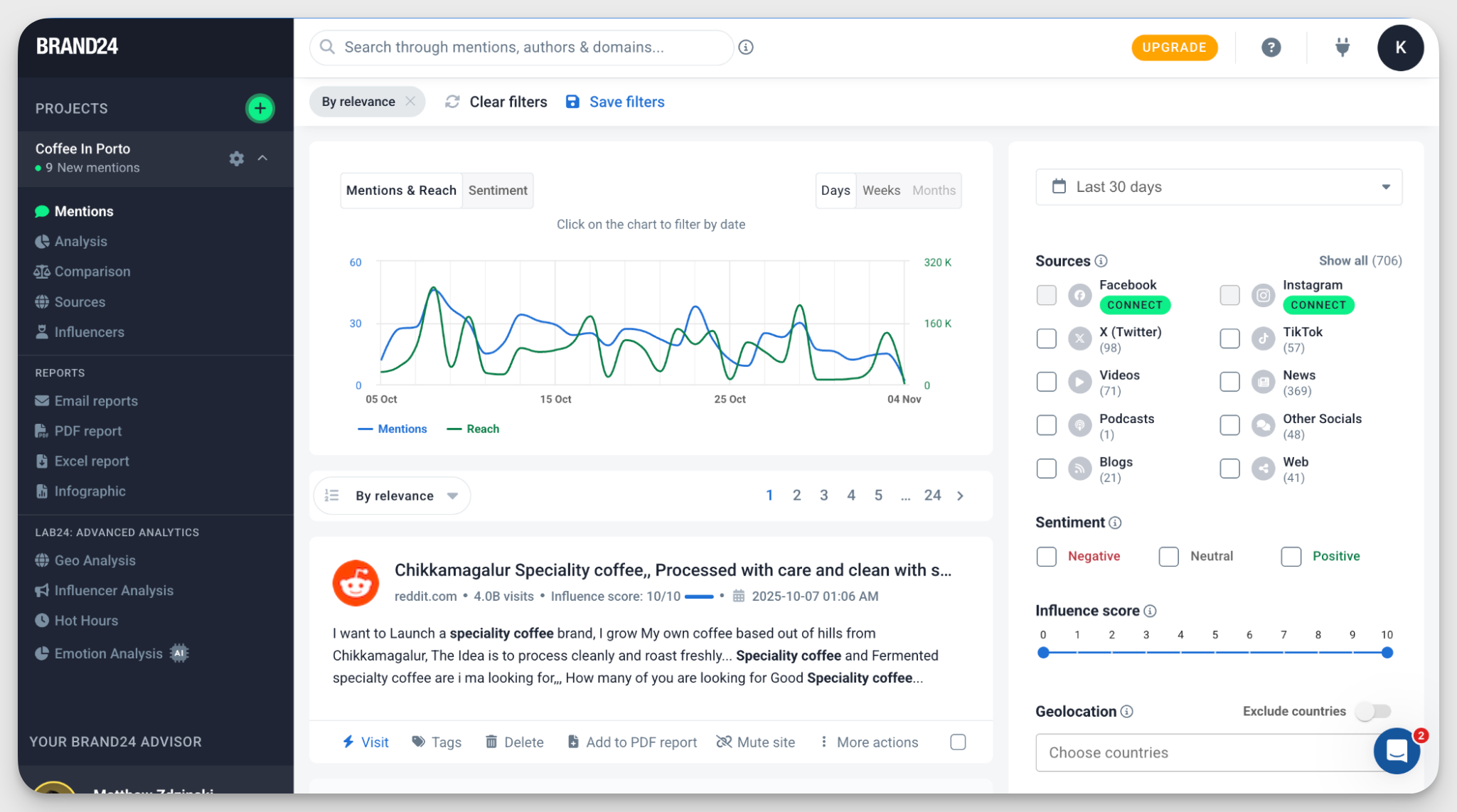
This is especially useful for PR and marketing campaigns that also have to take social media into account.
Pricing: Brand24 paid plans start at $149/per month, billed annually for individual subscription.
Customer service platform integrations
If you're a client-facing business, you probably get a lot of support requests through social media. Most consumers expect the customer support to react on social media within 24 hours or sooner, which puts you on quite a tight schedule.
Customer service integrations help you plug in social media to your existing customer support workflow and cut down the response time.
Intercom
Intercom combines live chat, email, and social messaging into one customer communication platform. You can automatically route social inquiries to the right team, send responses based on keywords, or hand off inquiries to a human when needed.
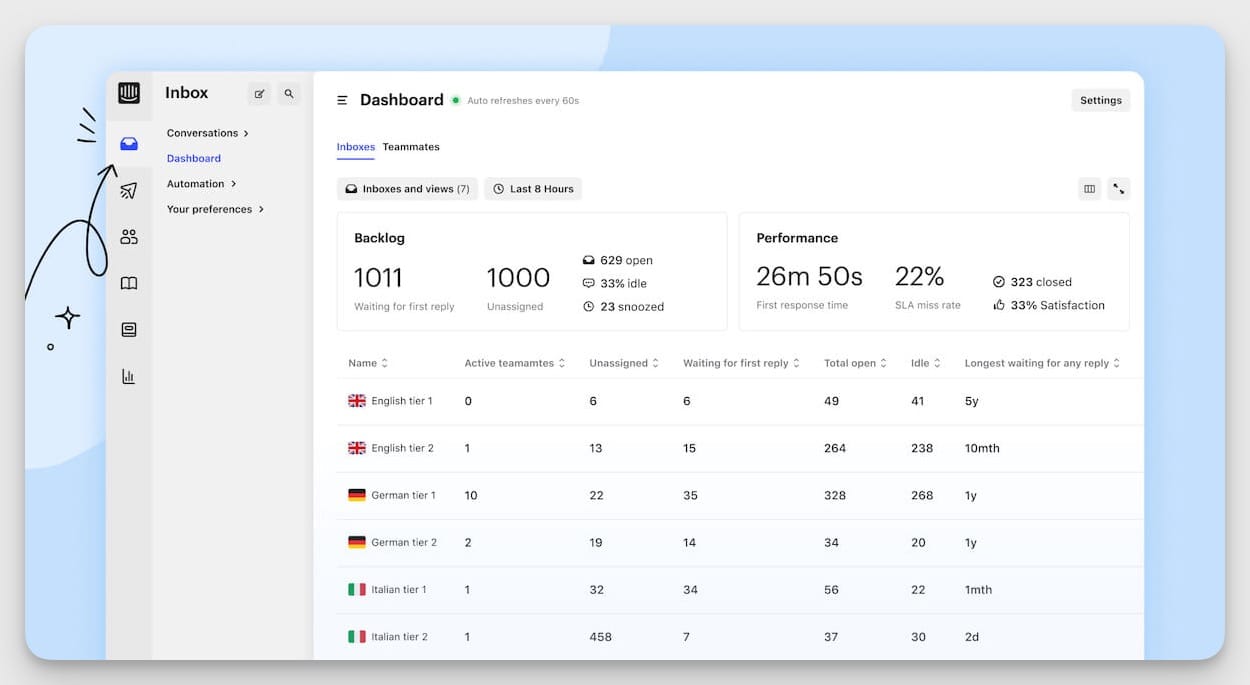
Here's a thing I liked: it also integrates with CRMs, so customer conversations from social media connect to their full profile and history. Intercom is a good fit for SaaS companies or businesses with complex customer journeys.
Pricing: Intercom’s paid plans start at $29/month per seat, billed annually. Their AI Agent Fin comes as an add-on for $0.99 per resolution.
Freshdesk
Freshdesk brings together customer support from email, social media, phone, and chat into one ticketing system.
The platform’s AI-powered bot, Freddy AI, handles common questions and routes tickets to the right team members. You can set up SLA tracking, use canned responses for faster replies, and automate ticket assignments based on keywords or urgency.
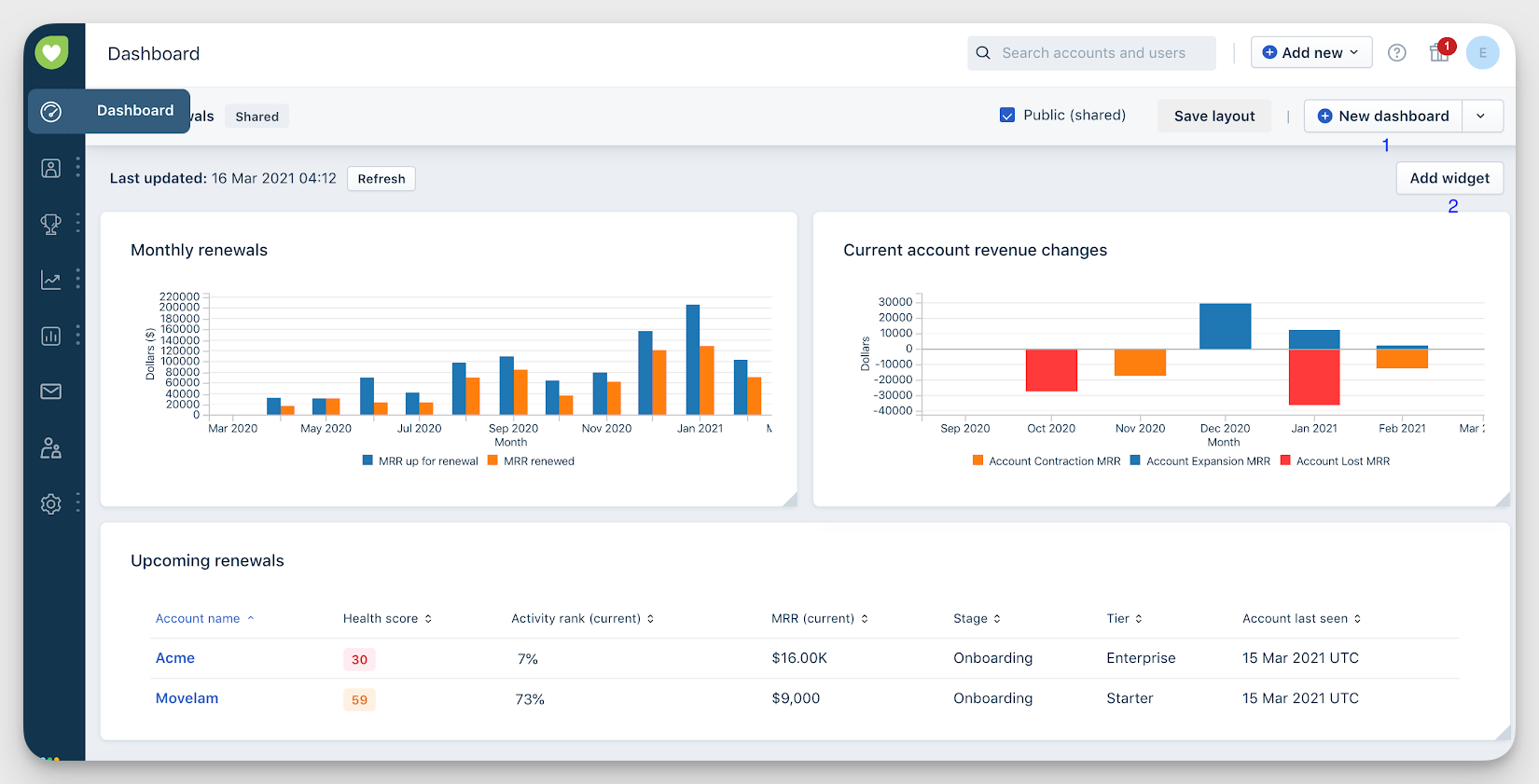
Freshdesk helps you scale support operations and keep response times in check across multiple channels without being too overwhelmingly complex.
Pricing: Freshdesk starts at $15/month per agent, billed annually. AI agent Freddy costs an additional $29/agent/month.
CRM & marketing automation integration tools
Proving social media ROI often means tying it back to sales, leads, and customer relationships. But making that connection isn’t always easy.
CRM and marketing automation integrations bridge that gap. They connect social activity with the rest of your marketing and sales data, helping you see who engaged and what happened next.
With the right tools, you can follow a customer from their first comment to their first purchase, track which social campaigns influence deals, and nurture those relationships automatically.
Social CRM integrations
Social CRM tools connect your social media activity to customer records, so you can see how social interactions fit into the full customer relationship.
They track which leads came from social, log conversations, and help sales teams follow up with context. It's a very useful integration if you're an actively growing brand in industries that have a lot of customer interactions, like SaaS or retail.
Hubspot
HubSpot connects social media to its CRM and marketing hub, tracking which social posts drive traffic, leads, and conversions.
You can publish content, monitor engagement, and see which social interactions turn into contacts. When someone fills out a lead ad form on Facebook or Instagram, HubSpot automatically creates their contact record in the CRM.
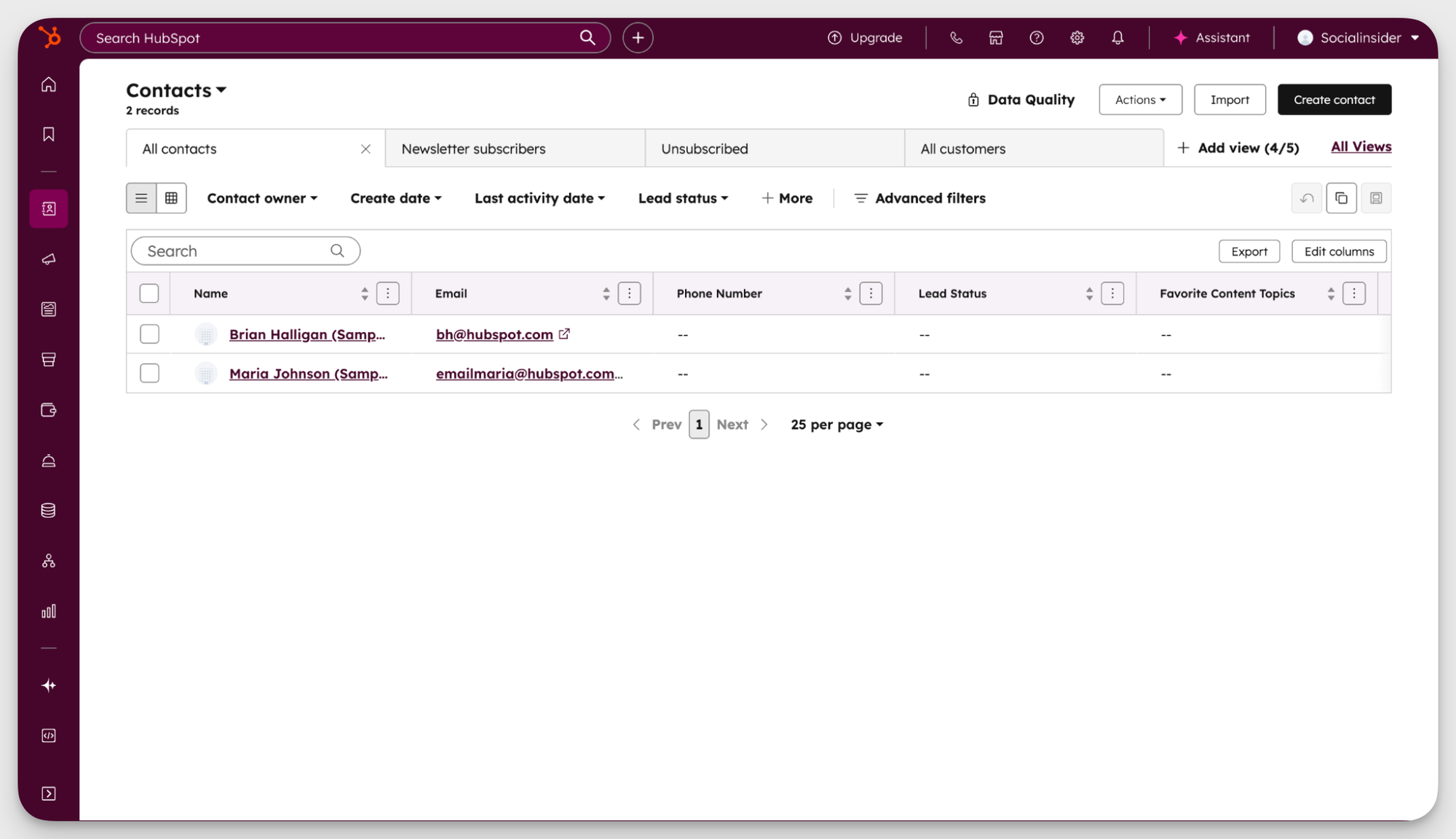
I like HubSpot for teams that are inbound-focused and want to see the full funnel, from social post to closed deal.
Pricing: The basic HubSpot CRM is free. However, if you want to use the social media functions, you’ll have to purchase Marketing Hub Professional starting at $800/month, billed annually.
Zoho CRM
Zoho CRM integrates with major social media platforms to track conversations, capture leads, and manage customer interactions. Comments, mentions, and profile visits show up in contact timelines, so you know how warm your lead is before reaching out to them.

You can also run social campaigns directly from Zoho and measure how they contribute to sales goals. The integration is straightforward and more affordable than Salesforce or HubSpot.
Pricing: Zoho CRM has a free version, but it’s pretty simple. For more professional use, their paid plans start at $14/month per user, billed annually.
Marketing automation platforms
While social CRM tools focus on tracking customer interactions, marketing automation platforms help you develop those relationships and push the customers down the funnel.
These tools aren’t always built specifically for social media. However, they connect the dots between your social campaigns, email, and the rest of your digital marketing. You can see how your social media efforts contribute to leads entering automated campaigns and track conversions influenced by social interactions.
Here’s how three marketing automation integrations can help social media managers prove their ROI:
ActiveCampaign
ActiveCampaign is a marketing automation platform for small to mid-sized teams, bundling email, CRM, automations, and ad integrations.
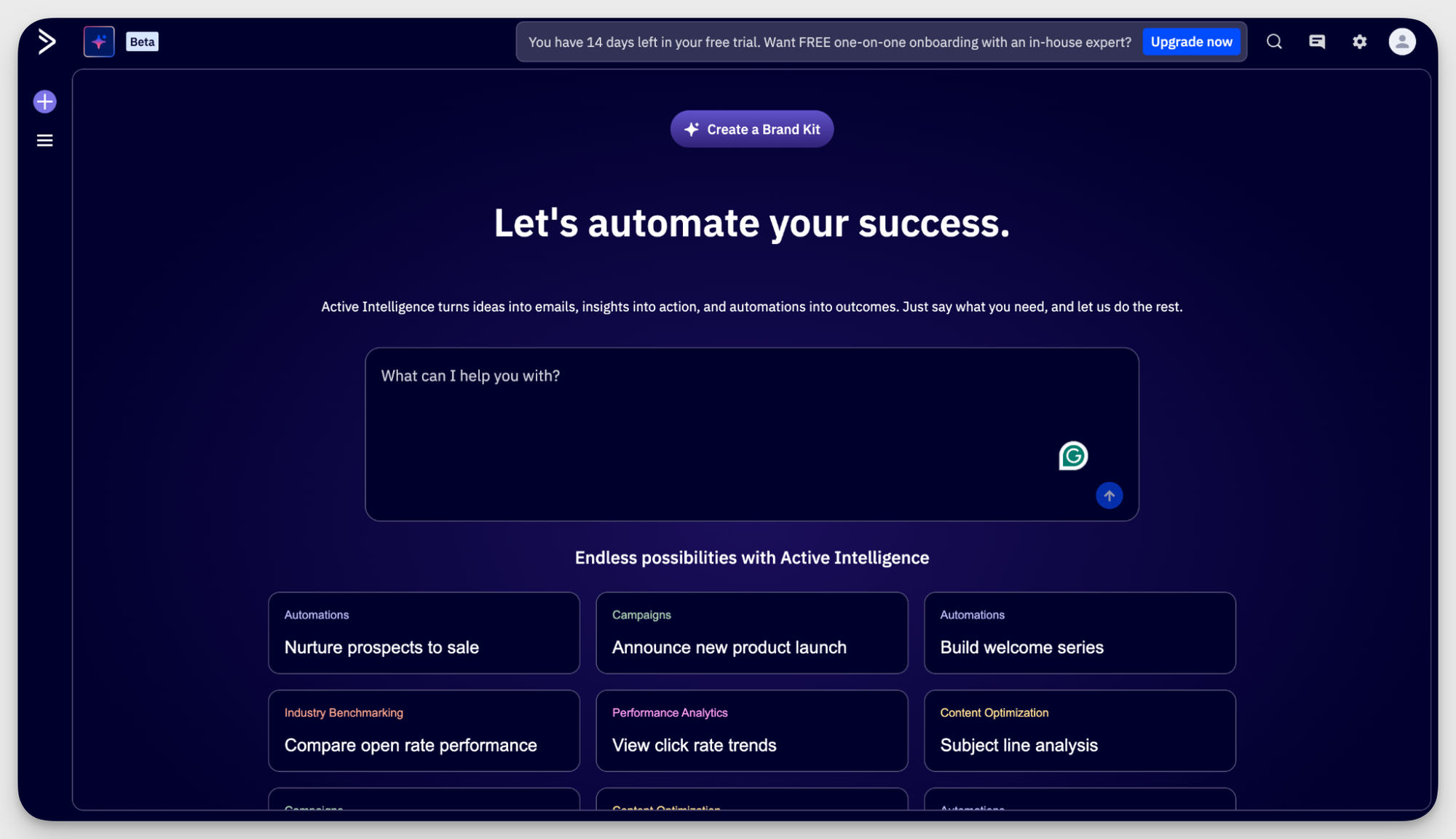
It natively connects with Facebook Lead Ads and Facebook Custom Audiences, and it supports LinkedIn Lead Gen Forms, so contacts from social ads can flow straight into automations for follow-up and segmentation.
For social media professionals, that means you can capture leads from Meta or LinkedIn, trigger automated marketing sequences immediately, and sync or remove contacts from ad audiences as they progress. This helps you tie social clicks and forms to conversions inside one system.
Pricing: ActiveCampaign’s paid plans start at $81/month for the email and WhatsApp bundle. If you’re only interested in email automations, you can start at $15/month (billed annually) for 1000 email contacts.
Customer.io
Customer.io is a marketing automation platform for data-driven marketing teams. It uses real-time customer data from your site, app, and CRM to trigger messages across email, SMS, push, and in-app.
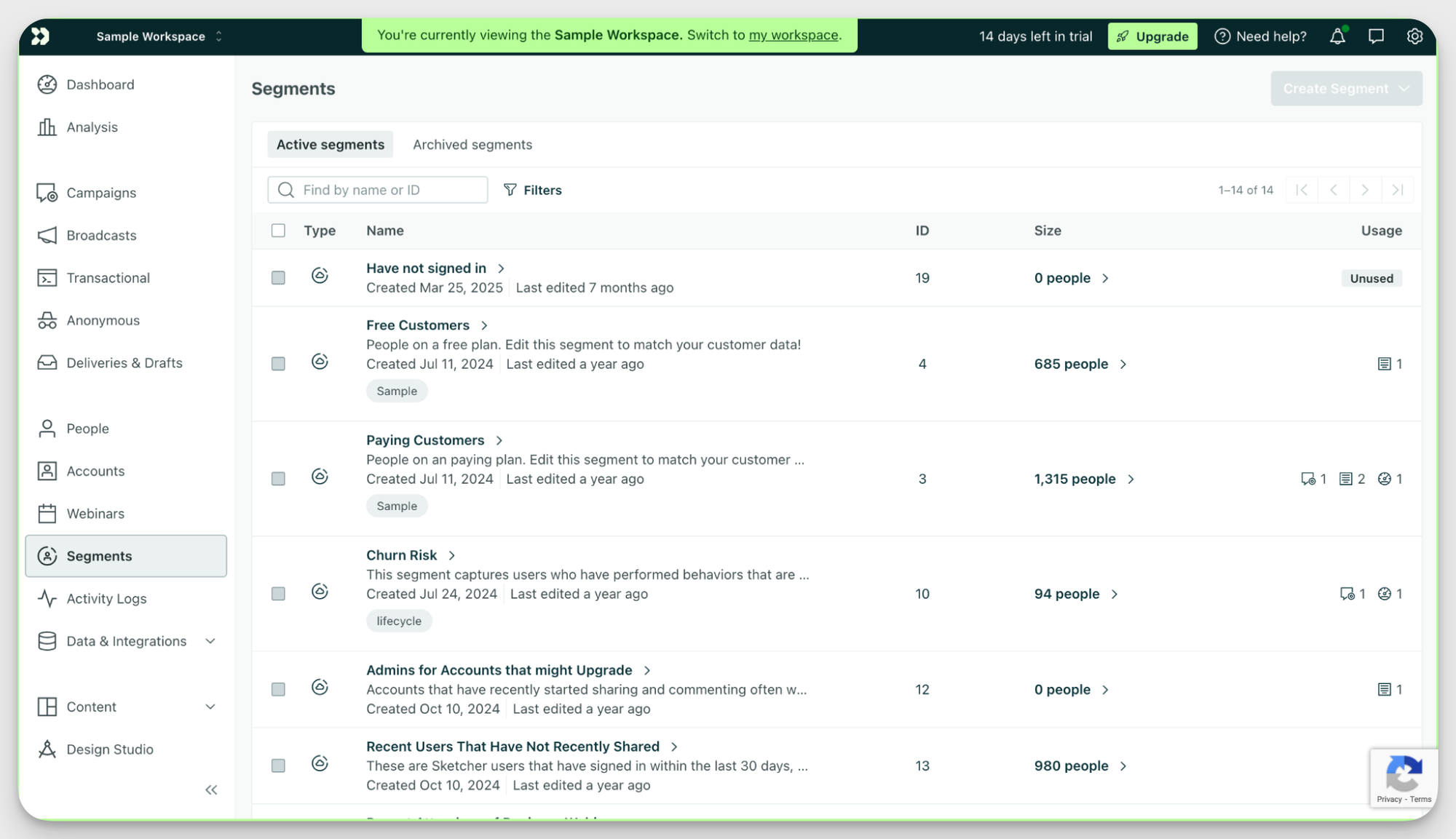
Customer.io can sync segments to Facebook and Instagram for retargeting or lookalikes and take in the leads from Facebook Lead Ads. The platform will route those contacts into automated journeys, so you can see how social engagement contributes to sign-ups and purchases over time.
Pricing: Customer.io paid plans start at $100/month, billed monthly for 5,000 profiles.
Lead management and nurturing tools
Marketing automation tools help you run campaigns and coordinate customer touchpoints. Lead management and nurturing tools then turn the new lead from a social ad, form, or comment into a paying customer.
These platforms track where leads come from, segment them by behavior, and deliver the right messages at the right time.
For social media professionals, that means you can make sure the leads you generate are followed up on, nurtured, and sent off to sales with context.
Klaviyo
Klaviyo uses customer behaviour data to trigger messages across email, SMS, and push channels. Social media teams can sync segments to platforms like Meta, TikTok, or X and retarget engaged audiences.
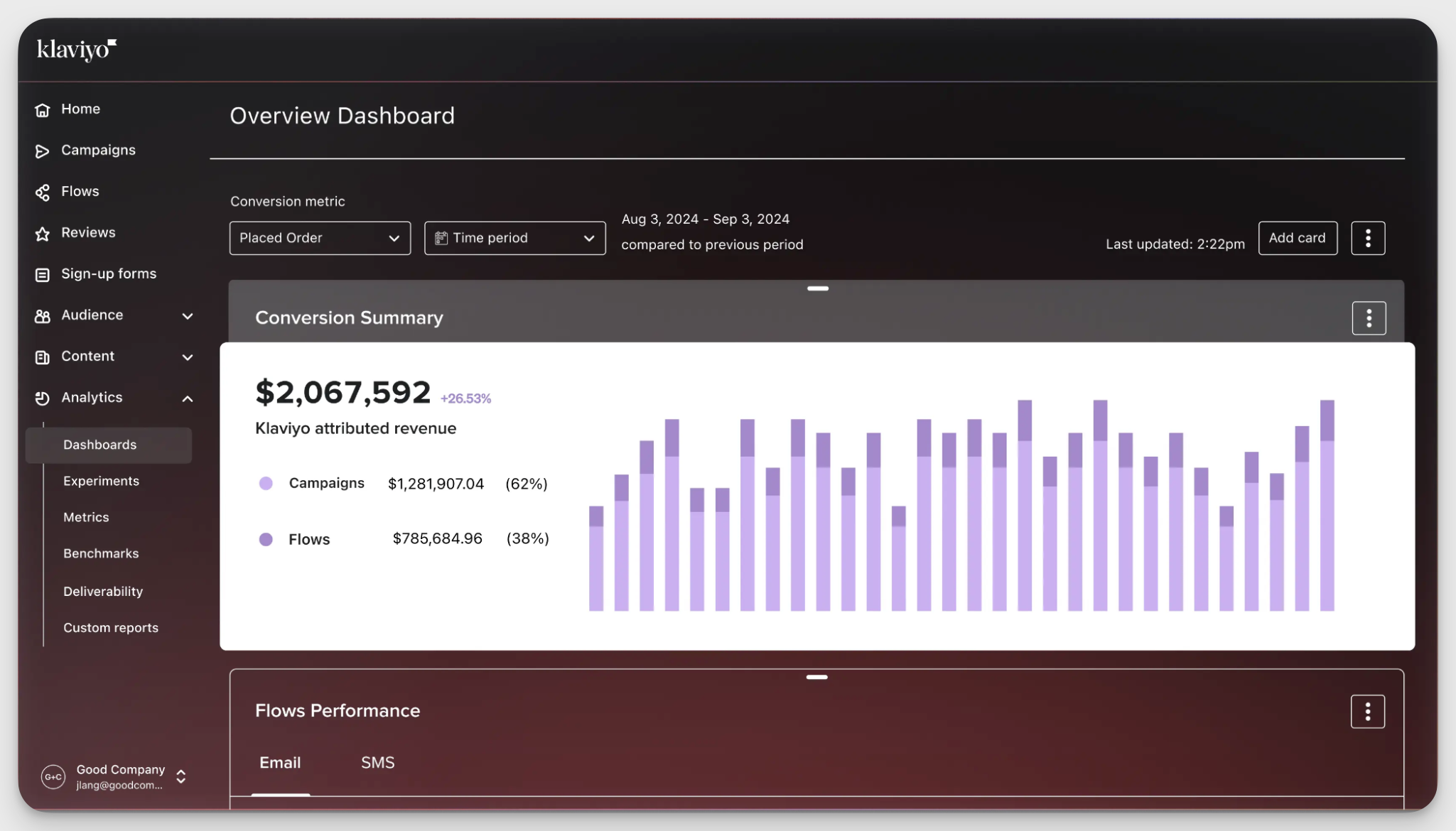
Leads from social ads flow straight into your automation sequences, and you can map social interest to actual purchases. It’s especially useful when you want to measure how well social media buzz converts.
Pricing: Klaviyo has a free plan for under 250 active profiles. Paid plans begin at $45/month for email only and $60/month for email and SMS bundle.
Drip
Drip is a great fit for eCommerce brands that want to nurture leads through email and automation. On the social side, it connects directly to Facebook Lead Ads and Custom Audiences, so leads from social campaigns flow into your email list or workflows.

You can keep your social ads, email marketing, and sales data talking to each other in one system. It’s a smart way to move someone from social interest to purchase.
Pricing: Drip’s paid plans start at $39/month for 2500 people in the email list.
Cross-platform publishing solutions
These tools connect to multiple social platforms so you can create, schedule, and publish content from one central hub. Instead of logging into each platform separately to post, you draft everything in one place and push it out across networks.
This category of integration tools helps you maintain consistent posting schedules, plan content in advance, and avoid the chaos of manual posting across multiple accounts.
Buffer
If you ask me, I'd say Buffer is a pretty straightforward scheduling tool that focuses on simplicity. I see its standout feature as the queue system, where you load up content, and the platform automatically publishes it at your pre-set optimal times.
This works great for teams that batch-create content and want a set-it-and-forget-it approach.
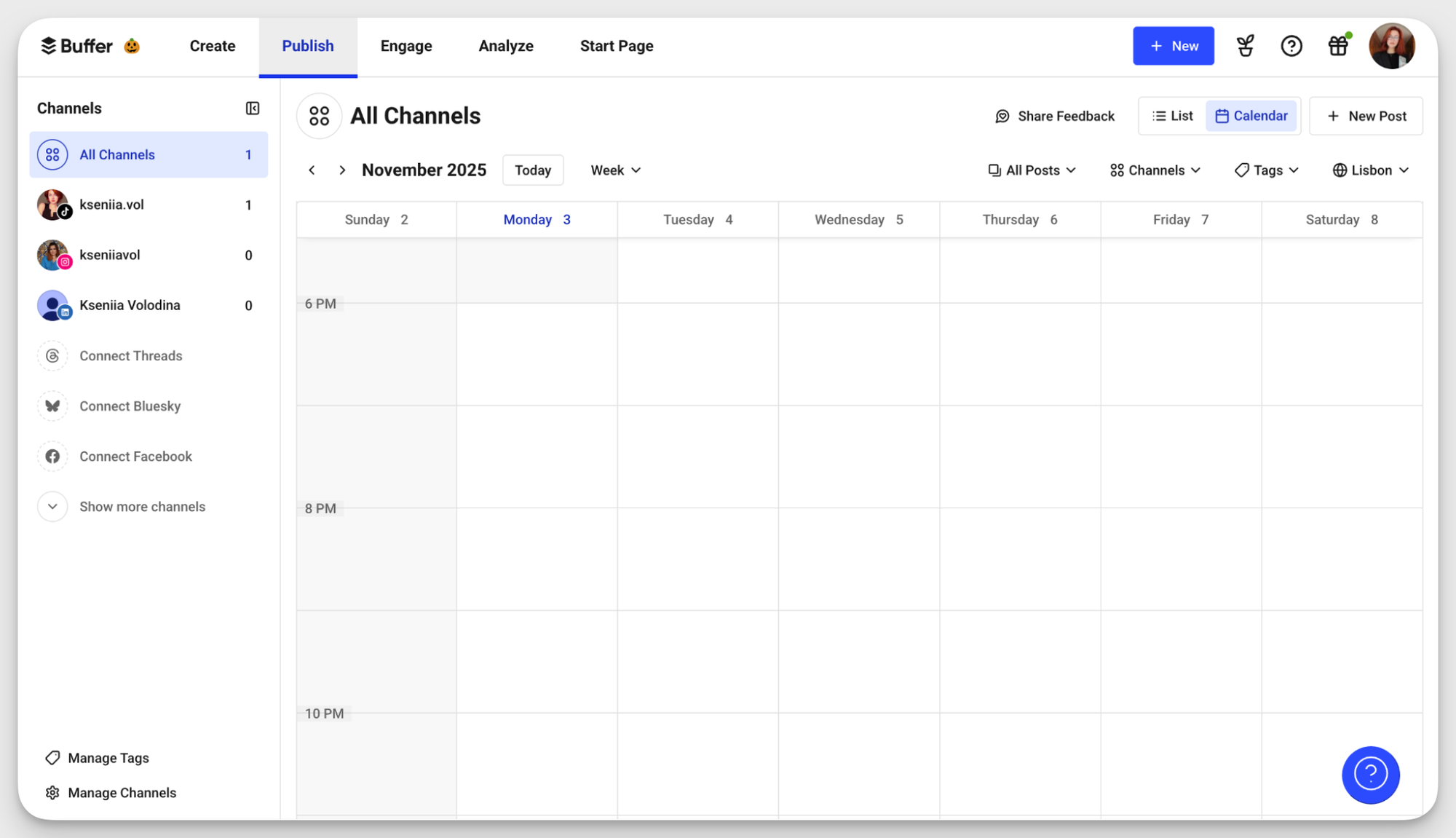
Pricing: Buffer has a free version for up to 3 channels. Paid plans begin at $5/month per channel yearly.
Loomly
Loomly is a social media management tool made for teams that plan, approve, and publish content across multiple platforms from one place. It’s a solid choice for growing brands or agencies managing multiple clients and channels.
Here's what I liked about it: the built-in collaboration workflow helps immensely when you have to approve posts with multiple stakeholders.

Pricing: Loomly has a free plan with 3 accounts and basic analytics. The Starter plan is $49/month yearly.
Content calendar integrations
Most social media publishing tools have built-in calendars, but some teams (me included) prefer keeping the calendar separate. This usually happens when you're planning more than just social — think blog posts, email campaigns, and social content all in one view.
It also makes sense when you need external approvers or stakeholders to access the calendar without paying for extra seats in your publishing tool or giving them full access to your social accounts.
These tools make it easier to plan your content and campaigns, avoid bottlenecks, and ensure consistency in your posting.
Notion
Here comes one of my favorites. Notion is a modular workspace where you build databases, wikis, and project boards in one place. This platform is very flexible yet easy to set up: your calendar lives alongside campaign briefs, brand guidelines, and meeting notes. Notion also has many ready-made templates.
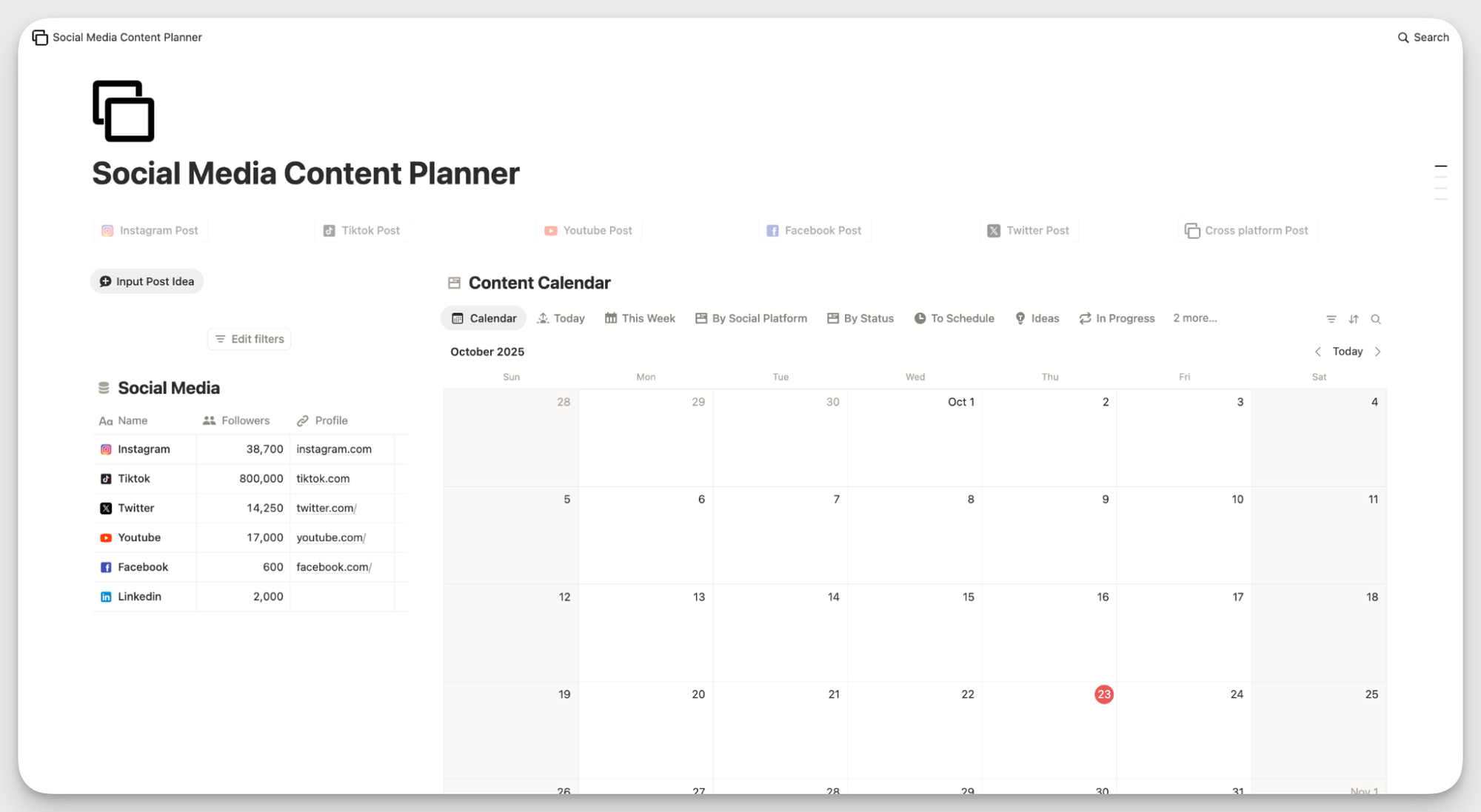
I personally use Notion for projects where I need to give context to every piece of planned content, not just spread the posts across the month.
Pricing: Loomly has a free plan with 3 accounts and basic analytics. The Starter plan is $49/month yearly.
Airtable
Airtable is a spreadsheet-database hybrid with multiple views and automation. It’s almost like creating your own app, so it fits teams managing complex operations. Relational databases help you link your content calendar to campaigns, asset libraries, or performance tracking tables.
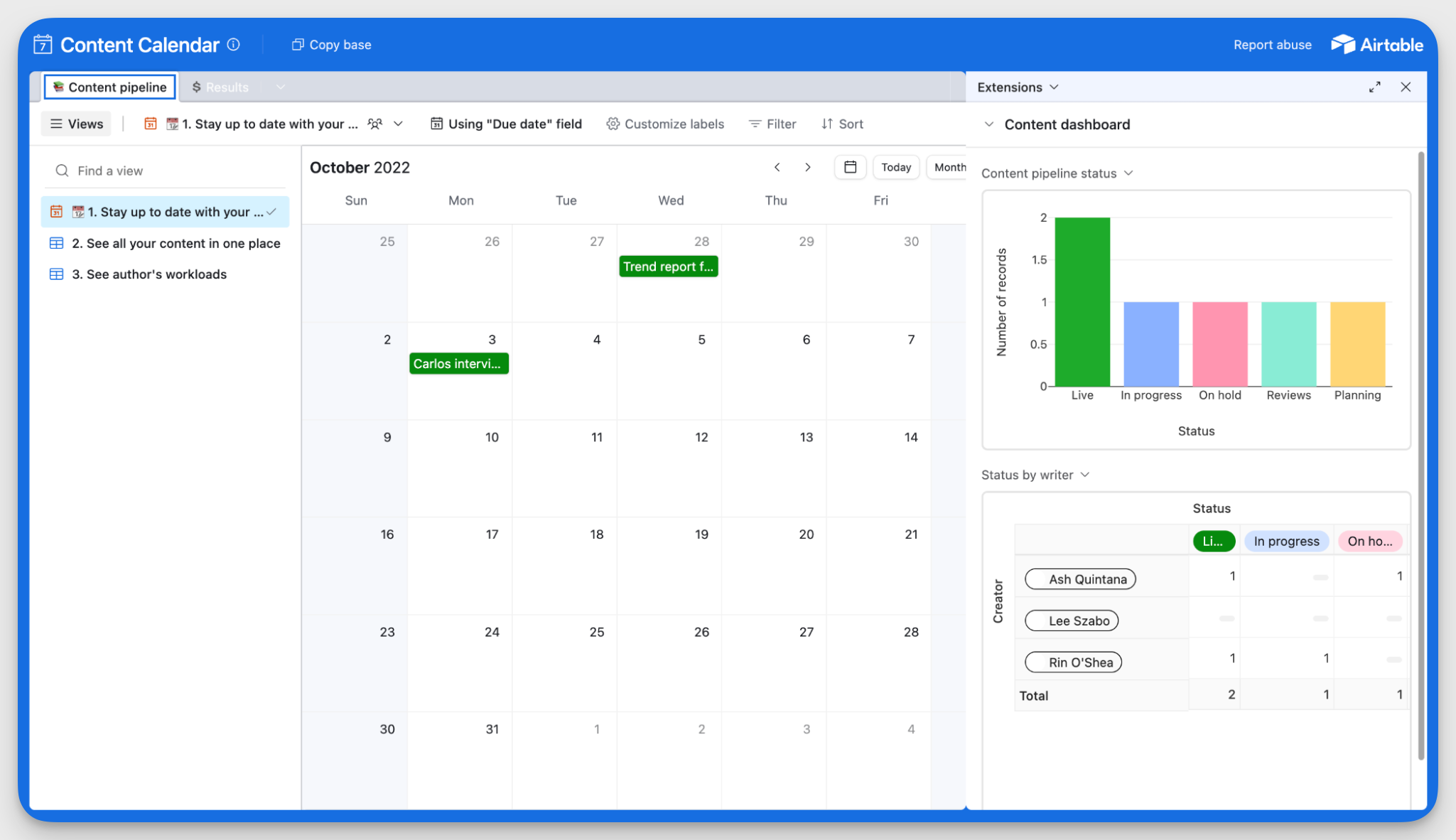
Mind it that Airtable’s flexibility is not always an upside, though — it also means you have to set it up and maintain it.
Pricing: Airtable offers a free plan for individuals or very small teams. Paid plans start at $20 per user/month (billed annually).
How to choose the right tools for your stack?
There are hundreds of social media integrations out there. While it’s tempting to add more to your pipeline and go full Inspector Gadget, the best tech stack is one that fits your workflow, not overwhelms it.
The right mix keeps things efficient and budget-friendly, which your executives will always appreciate.
Here’s what to keep in mind when choosing your perfect social media integration setup:
- Assess your workflow gaps. Look at where your current process falls short. Maybe content planning and approvals take forever, or your analytics are too shallow. Some integrations can fix multiple problems at once, but they often come at a higher price.
- Establish your cost vs. capability trade-offs. Decide which features you truly need and which you can compromise on. I like to outline four scenarios for executive sign-off: ideal, favorable, doable, and scrappy. Put the bare essentials into the scrappy one and build on top of it.
- Check for scalability. Choose tools that can grow with you. What fits your team today should still make sense when your content volume or headcount doubles next year.
Final thoughts
Social media integration tools can take a lot of weight off your shoulders, automating what used to be manual and giving you a clearer view of what drives results. The trick is to stay intentional: pick the tools that fit your workflow, not the other way around.
But no amount of my recommendations can really give you the full picture. So before you commit, always test. Most platforms offer free trials or demos, so take them for a spin and see how they feel in your day-to-day.
FAQs on social media integration tools
Why is social media integration important?
Social media integration is important because it helps bring all your communication channels together, making it easier to manage your online presence, analyze performance, and connect with your audience. By integrating social media into your business or strategy, you save time, gain meaningful insights about your competitors, and can make data-driven decisions that help you grow and stand out in your field. It transforms scattered efforts into a unified, efficient workflow, empowering you to be more strategic and impactful with your digital communication.
Kseniia Volodina
Content marketer with a background in journalism; digital nomad, and tech geek. In love with blogs, storytelling, strategies, and old-school Instagram. If it can be written, I probably wrote it.
Analyze your competitors in seconds
Track & analyze your competitors and get top social media metrics and more!
You might also like
Improve your social media strategy with Socialinsider!
Use in-depth data to measure your social accounts’ performance, analyze competitors, and gain insights to improve your strategy.


